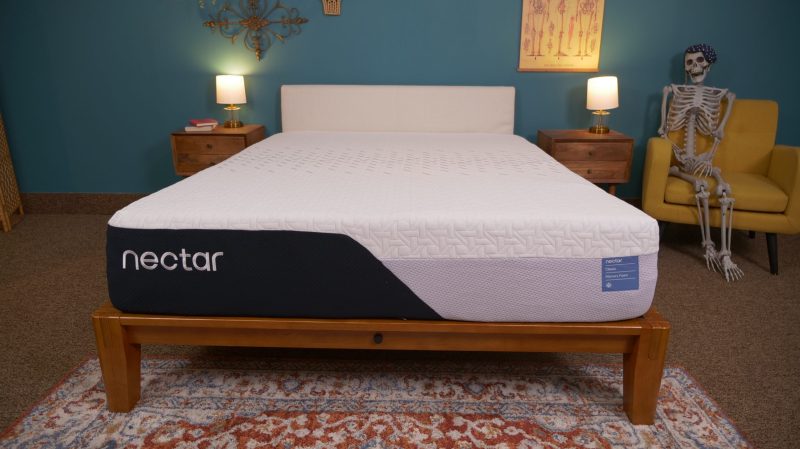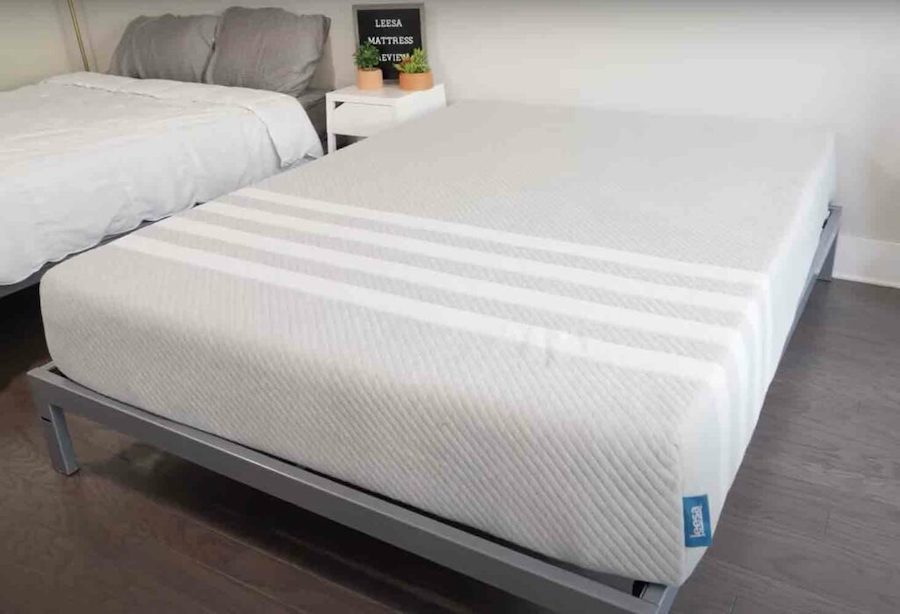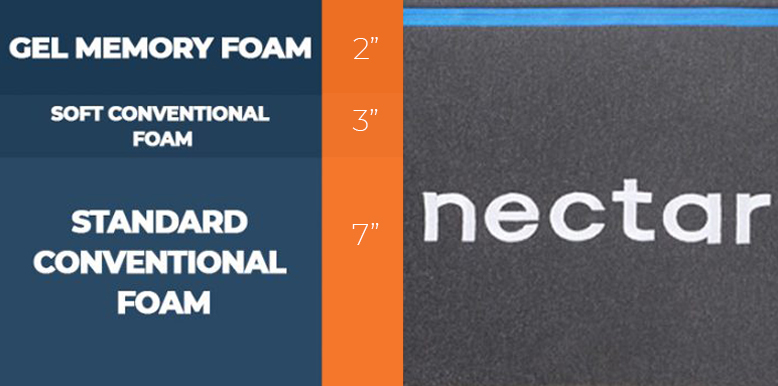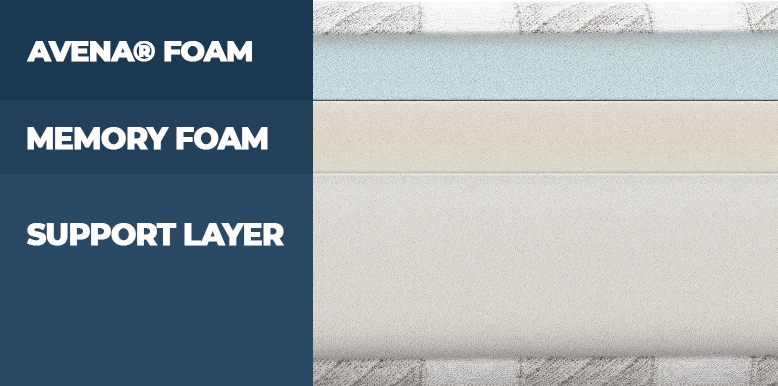If you’re a fan of memory foam mattresses, the names Nectar and Leesa have likely been on your radar while searching for a new bed. These flagship mattresses from the companies of their respective names boast an all-foam construction that includes the highly sought-after memory foam, a material known for its great pressure-relieving capabilities.
In our Nectar vs. Leesa mattress comparison, we’ll not only look at how these beds compare but also how they differ. By providing detailed qualities of each bed and seeing how they rate against each other, you should have a better idea of which one is your ideal match.
Product
Type
Score
Quick Comparison: Nectar vs Leesa
Who I’d Recommend the Nectar For
- People who want to save a little more money – The price gap between these two mattresses isn’t as great as some comparisons, but those looking to save some extra cash will prefer the Nectar’s price point.
- Sleepers who enjoy a slightly firmer feel – While both beds have a mid-range firmness, the Nectar is rated slightly firmer at a 6.5 out of 10, compared to Leesa’s 5.5 rating.
- Shoppers who want a longer trial and warranty period – This brand has shattered previous industry standards by offering a 365-night trial period and their Forever warranty.
Who I’d Recommend the Leesa For
- Socially-conscious shoppers – As partners of the Arbor Day Foundation, this company plants one tree after the sale of each mattress. Additionally, they donate one bed with the sale of every 10, encourage employees to volunteer, and help the current and previously homeless.
- People who want to shop locally – The Leesa is proudly made in the United States.
- Sleepers who want more response – The top foam layer in the Leesa should provide some buoyancy, and while it’s not going to be as much as innerspring or latex options, this will have more than the Nectar.
Comparing Nectar vs Leesa: Top Similarities
- All-foam – Both of these mattresses boast an all-foam design.
- Memory foam – The Nectar and Leesa each contain memory foam. While this material is at the top of the Nectar, memory foam is located in the center of the Leesa.
- Medium firmness – The Nectar and Leesa each have a medium firmness.
Comparing Nectar vs Leesa: Key Differences
- Price – The Nectar is priced slightly cheaper than the Leesa.
- Trial and warranty – The Nectar goes above and beyond with a year-long trial and a Forever warranty, whereas Leesa offers a more industry-standard 100-night trial and a 10-year warranty.
Comparing Firmness, Support & Feel
Firmness
It’s important to remember that while mattress firmness is a valuable asset to determining the right bed, it’s also subjective; a heavier person will experience a mattress differently than a lightweight person. Based on our testing, we consider the Nectar to be a 6.5 on our 10-point firmness scale (where 10 is the most firm) and the Leesa a 5.5. This means both beds have a medium firmness, though Nectar is the firmer of the two.
Support
Each bed’s comfort layers feel soft when interacting with them and each does a great job of catering to back sleepers, people who prefer to sleep on their stomachs, and side sleepers. However, Nectar is particularly great for side sleepers who need additional pressure relief in their hips and shoulders because of its expanded memory layers.
Significantly heavier sleepers may need to experiment to find out if they prefer the support of a firmer mattress.
Feel
There is a noticeable difference in the response time of the Nectar and Leesa mattresses. While the Nectar’s top levels give it a slow response, its competitor’s top level snaps back into shape quickly. Although the Leesa has a slow-responding memory layer within its construction, the upper foam and dense base layer are very quick-responding.
The Leesa’s quicker response means it could be better for combination sleepers who adjust positions frequently or those with limited mobility who need something that fosters easier repositioning.
Comparing Sinkage and Bounce
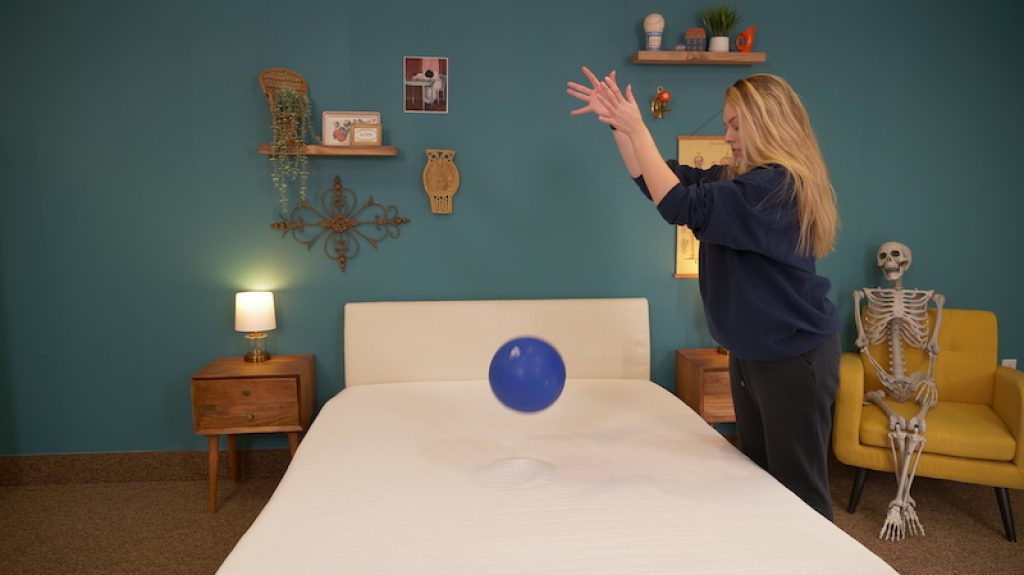
Sinkage and bounce are two items that are completely preference-based when it comes to buying a new bed. This is one area in the comparison to note a major difference between the brands.
Nectar’s memory layers hug its sleepers and have very little bounce. This is often the case for products that offer fantastic pressure relief; there is low bounce because of the memory materials.
Oppositely, Leesa has a high amount of bounce for a non-innerspring brand, and the level of sinkage is between a gentle cradle and a deep hug. The mattresses’ quick responsiveness makes it slightly easier to move around and reposition.
Comparing Motion Transfer
Sinkage and bounce are two items that are completely preference-based when it comes to buying a new bed. This is one area in the comparison to note a major difference between the brands.
Nectar’s memory layers hug its sleepers and have very little bounce. This is often the case for products that offer fantastic pressure relief; there is low bounce because of the memory materials.
Oppositely, Leesa has a high amount of bounce for a non-innerspring brand, and the level of sinkage is between a gentle cradle and a deep hug. The mattresses’ quick responsiveness makes it slightly easier to move around and reposition.
Comparing Cooling
People who sleep light and wake easily to motion (such as pets and children jumping into bed or partners tossing and turning) will delight in each product’s minimal motion transfer. Memory foam mattresses tend to perform best with motion isolation, particularly those with an all-foam construction. High levels of motion isolation can be experienced in both offerings.
Between the Leesa and Nectar, there’s not much of a difference when it comes to their ability to limit motion transfer, so if this is an important factor, either product should do the job.
Comparing Construction (Materials & Quality)
Nectar Construction
The Nectar is a memory foam mattress that is compressed and rolled up into a box for shipping to the purchaser’s home.
A poly-blend makes up the breathable and heat-wicking cover. This cooling surrounds the Nectar mattress, and it is white on top with a dark gray color surrounding the base. The Nectar stands at a total of 12 inches high and features a total of three foam layers.
- The first foam layer in this bed is built with 2 inches of memory foam material, which responds slowly and delivers pressure relief. This memory foam is also gel-infused to counteract overheating.
- The second layer is made up of a 3-inch thick soft premium foam. This foam unit provides a smooth transition from comfort to support.
- The base layer of the Nectar has a 7-inch thick standard conventional foam for compression support. This layer also provides a stable foundation for the mattress.
Leesa Construction
Leesa’s flagship mattress is a bed-in-a-box model that can be used with nearly every foundation. It ships to the United States, Canada, the U.K., and Germany.
The Leesa mattress’ iconic striped cover is a thick polyester blend and can be zipped off for spot cleaning. The mattress is 10 inches thick, and like the Nectar, is built with three foam layers.
- The top layer of the Leesa is 2 inches of foam with pin core holes to help cool your body and promote airflow. This layer is also what gives the Leesa added buoyancy for easier repositioning.
- The middle unit of the bed is made of a 4-inch memory foam that contours and relieves pressure. Unlike the Nectar, though, this memory foam doesn’t contain additional cooling gel.
- The base layer features a 6-inch thick supportive poly foam. This foam’s density also delivers durability and shape to the product.
Comparing Company Policies & Price
- Warranty – Leesa offers a 10-year limited warranty, and Nectar offers their Forever warranty.
- Shipping – Leesa ships for free to all 50 U.S. states, and the Nectar is only shipped for free to the contiguous U.S., with an additional fee for shipments to Alaska and Hawaii.
- Trial Period – Leesa’s trial period runs for 100 nights, and Nectar’s is 365 nights.
- Returns – You must wait at least 30 nights before returning the Leesa, and there’s a delivery fee for returns from outside the contiguous U.S. Returns are also free for the Nectar, except for those from Alaska and Hawaii.
- Price – The Nectar is about several hundred dollars cheaper than the Leesa.
[table id=180 responsive=scroll /]
Nectar vs. Leesa Compared Side-by-Side
[table id=179 responsive=scroll /]
Final Thoughts
Although the Nectar and Leesa share multiple similarities, there are specific features that differentiate them. The Nectar has a slightly firmer feel combined with extra cooling in the cover that some sleepers may prefer. Additionally, this bed comes with a longer trial and warranty at a cheaper price point than the Leesa.
Conversely, the top foam in the Leesa provides added buoyancy that the Nectar lacks, which could aid in repositioning for people with mobility issues or combination sleepers.
If you’re still unsure, though, you can take a look at our full-length reviews of each mattress for more details.
Product
Type
Score
More Nectar Comparisons:

Jill Zwarensteyn
Editor
About Author
Jill Zwarensteyn is the Editor for Sleep Advisor and a Certified Sleep Science Coach. She is enthusiastic about providing helpful and engaging information on all things sleep and wellness.
Combination Sleeper
